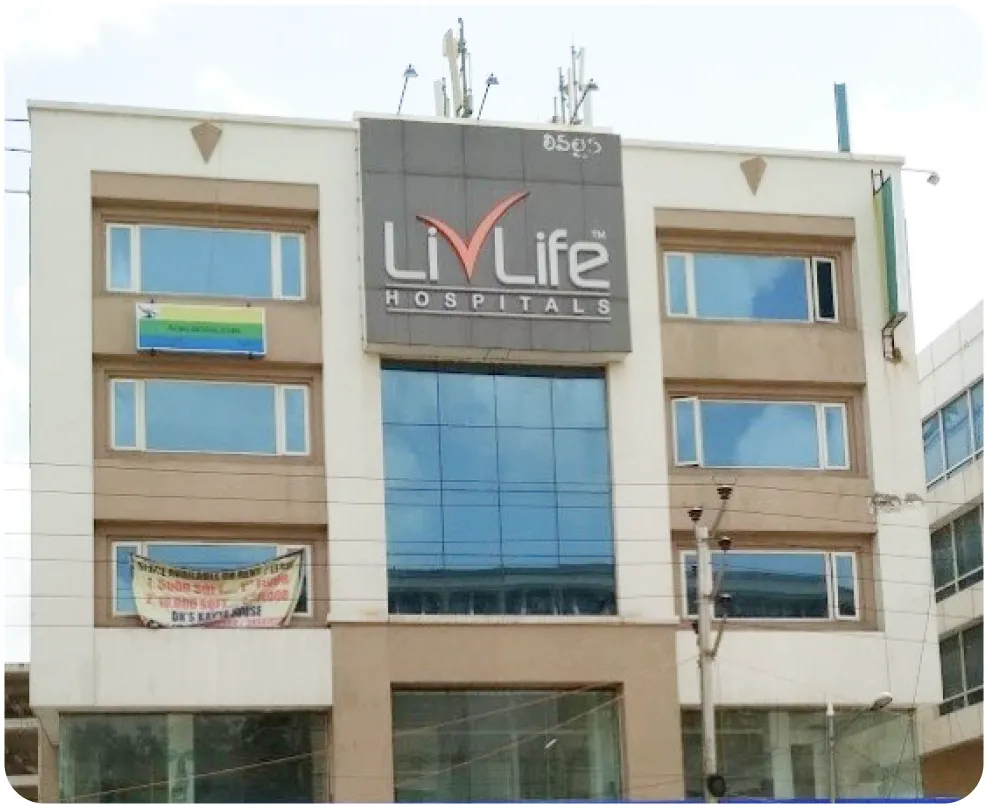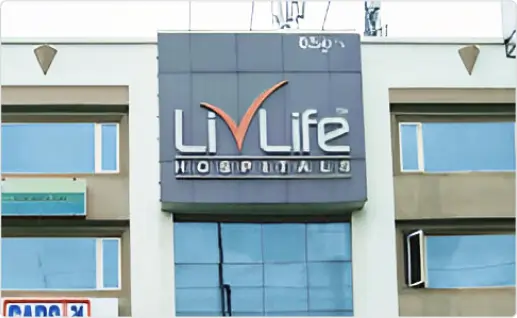Successful Treatments
Delivering outstanding healthcare services with high success rates across bariatric, general, and multispecialty surgeries.
At LivLife Hospitals, we have the best hernia surgeon in Hyderabad to cure your troublesome symptoms and give you a healthy life in the long run. We utilize the latest robotic and 3D HD laparoscopic technologies to ensure the best potential outcomes for our hernia patients. Right from the first consultation to post-operative care, LiveLife Hospitals will be committed to providing you a comprehensive and personalized hernia treatment in Hyderabad.

At Livlife Hospitals, we specialize in advanced bariatric surgery to help you achieve long-term weight loss and improve your overall health. Our expert team of highly skilled surgeons employs cutting-edge,
Why Choose LivLife Hospital for Hernia Surgery in Hyderabad?
LivLife is the top hospital for hernia surgery in Hyderabad and has a team of experienced and skilled professionals to take on even the most complex patient conditions.
From consultation to pre-operative and post-operative care, this hospital aims to provide comprehensive hernia treatment solutions. As a result, our doctors ensure optimal recovery and health outcomes for the patients.
For our hernia repair surgery in Hyderabad, we make sure to prioritize patient safety and satisfaction. Our doctors and the entire staff strive to offer personalized care and medical support to the patients, throughout their recovery journey.
At LivLife Hospitals, we offer both robotic as well as laparoscopic hernia surgery in Hyderabad, backed by advanced technologies and state-of-the-art facilities. Our technological supremacy enables us to conduct hernia surgeries with the utmost sophistication.

Dr. Nandakishore Dukkipati is a distinguished surgeon specializing in advanced laparoscopic and bariatric surgery. With years of experience and a commitment to patient care, he leads the surgical team at LivLife Hospitals, a renowned Bariatric Hospital in Hyderabad, focusing on innovative techniques that enhance recovery and minimize discomfort. Dr. Dukkipati is passionate about helping patients achieve their weight loss goals and improve their overall health through personalized treatment plans. His expertise and compassionate approach make him a trusted choice for individuals seeking surgical interventions for obesity and related health issues.
More About DoctorDelivering outstanding healthcare services with high success rates across bariatric, general, and multispecialty surgeries.
Led by some of the most distinguished specialists, with decades of experience in providing superior healthcare solutions.
Prioritizing patient satisfaction with excellent recovery rates, seamless care experiences, and compassionate medical support.
Get trusted insights and advice from Dr. Deepti J. Thakkar on a range of surgeries and wellness tips.
In the case of a hernia, surgery is one of the critical treatment options. When a patient encounters hernia symptoms, an organ within the body will push through the tissue or muscle that holds it. Most commonly, the hernia formation takes place in the groin or abdomen region.
Over time, the hernia can grow out of control and cause pain. Patients start to feel discomfort and excruciating pain while coughing, sneezing, or doing any physical activity. If the hernia problem interrupts the daily lifestyle or causes unbearable pain, your doctor might suggest surgery.
Hernia surgery will allow the surgeon to push the affected organ and the associated herniated tissue, back to its actual place. Following that, the surgeon will also reinforce the weakened barrier by using a surgical mesh or stitches.
Not all hernias demand instant surgical treatment, but that becomes an obvious approach in case the condition worsens over time. Some hernia symptoms at the early stage can be treated with medications. But, most of the other complex types demand surgical repair.
There are different types of hernia surgery options that doctors might consider for your treatment, depending on your specific condition. They include
As stated earlier, not all hernias need immediate surgical attention, as minor conditions can be treated with proper medications. Our doctors at LivLife Hospitals will recommend hernia surgery in Hyderabad, only if it has grown big and is causing unbearable pain or discomfort. To diagnose the severity of your hernia condition, our surgeons will run some screening tests, determining your eligibility for the surgical procedures.
Undoubtedly, contacting a hernia specialist in Hyderabad and getting surgery is the only option to get rid of the painful and worsened hernia condition. Waiting too long without surgery might lead the hernia to grow larger enough, making it difficult for the doctors to fix. To help you feel more confident about getting a hernia repair surgery in Hyderabad, here are some benefits of the procedure for you to count on:
Just like any other medical procedure, hernia surgery might also encompass certain complications in rare circumstances, which include:
Here are some tips that doctors will suggest you for post-operative care after hernia surgery:
Hear from those who’ve transformed their lives with us:
"Before I came to LivLife Hospital, I struggled with my weight for years. After undergoing gastric sleeve surgery, I lost over 80 pounds in less than a year! The team at LivLife supported me through every step of the process, from my initial consultation to post-operative care. Now, I can play with my kids without feeling out of breath. This journey has transformed my life, and I couldn't be more grateful!"
"I had a long history of weight-related health issues, including diabetes and high blood pressure. After extensive research, I decided on a duodenal switch procedure at LivLife Hospital. The results have been incredible—I've lost 120 pounds and am off all my medications! The staff was incredibly supportive, providing a holistic approach that included nutrition and lifestyle counseling. I feel healthier and more energetic than ever!"
"Deciding to have weight loss surgery was one of the best decisions I've ever made. The team at LivLife Hospital in Hyderabad made me feel comfortable and informed throughout the entire process. I opted for the gastric bypass, and I've lost 90 pounds so far. The psychological support was invaluable, helping me change my relationship with food. I now enjoy activities I never thought I could, like hiking and dancing!"
"My weight had held me back for so long, affecting my confidence and quality of life. After attending a seminar at LivLife Hospital, I chose to have an endoscopic sleeve gastroplasty. In just a few months, I've lost over 70 pounds and feel fantastic. The personalized care and attention from the surgeons and staff made all the difference. I now have a renewed sense of purpose!"
"I was at my lowest point before I found LivLife Hospital. After my sleeve gastrectomy, I lost over 50% of my body weight in less than a year! The hospital staff not only helped me with surgery but also provided ongoing support with nutrition and exercise. I now have the energy to engage with my family and live my life fully. This journey is about so much more than just weight loss; it’s about reclaiming my life!"
Explore inspiring real-life stories with interactive sliders showing dramatic before-and-after results.

The common types of hernias that patients experience include:
The hernias are categorized differently based on the site of occurrence, giving doctors an idea of picking the right approach with painless hernia surgery in Hyderabad.
Yes, LivLife is the best hospital for hernia surgery in Hyderabad as it offers advanced technology-driven treatment solutions irrespective of the complexities of your condition. Whether you seek Hiatal, Femoral, Umbilical, or Inguinal hernia surgery in Hyderabad, our expert surgeons are capable of addressing treatment for all reported types.
The actual cost of hernia surgery in Hyderabad might differ depending on your personalized diagnosis report and treatment plan. But to give you an estimate, the overall cost of hernia repair surgery can range between Rs. 20,000 to Rs. 1,50,000. The cost will vary depending on the experience of surgeons and the type of hernia you are experiencing. If you seek affordable hernia surgery in Hyderabad, we can help you attain that at LivLife Hospitals. Schedule your consultation today!
You must be aware of how your body responds to the worsening hernia, and respond to the symptoms. If you notice severe fever or chills, frequent constipation, redness, rapid increase in the size of the hernia, frequent vomiting, unbearable pain in the abdominal/groin region, or other such symptoms, please contact our doctors at LivLife Hospitals, without further delay.
When the hernia occurs in the outer ground or upper thigh region of your body, it is referred to as a femoral hernia. These hernias occur in the deep passages, referred to as the femoral canals. A femoral hernia condition isn’t as common as the inguinal counterpart and is more likely reported in women than men. If not repaired, this particular hernia can cause serious complications. At LivLife Hospitals, we offer risk-free and safe femoral hernia surgery in Hyderabad.
Umbilical hernias, as the name suggests, occur near the belly button. They are mostly common in newborn babies, especially the ones who are born prematurely. When in babies, it is expected for the umbilical hernias to close by themselves over time. But, the problematic situation occurs when umbilical hernias are diagnosed in adults. In that case, you can reach out to us and avail of our umbilical hernia surgery in Hyderabad.
Hiatal hernias tend to occur when the upper region of your stomach tends to bulge into your chest through the small opening in your diaphragm, named Hiatus. This small opening, Hiatus, will then allow the esophagus to pass through the diaphragm. At LivLife Hospitals, we offer hiatal hernia surgery in Hyderabad, ensuring a complication-free recovery for our patients.
An inguinal hernia occurs in the inner part of the groin region. The reason for its occurrence is often when the intestine tends to protrude through either of the two inguinal canals, passages present in the lower part of the abdominal wall. As per the researchers, around 3% of women and 27% of men will be developing an inguinal hernia in their lifetime. Considering the common occurrence of this condition, we offer a quick diagnosis followed by inguinal hernia surgery in Hyderabad.
There is no fixed terminology for a hernia repair surgery procedure. This is because hernia surgery can be classified as major or minor, depending on the technique recommended for a particular patient. For instance, open hernia surgery is considered a major procedure, whereas laparoscopic hernia repair is stated as a minor treatment.
It will take around 1 or 2 weeks for you to return to work after your hernia surgery. But still, you might have to follow the post-operative care guidelines such as minimal physical labor, light exercises, no smoking, following a healthy diet, drinking more fluids, etc. You must wait for at least 4 to 6 weeks before you can do heavy lifting or be part of strenuous activities.